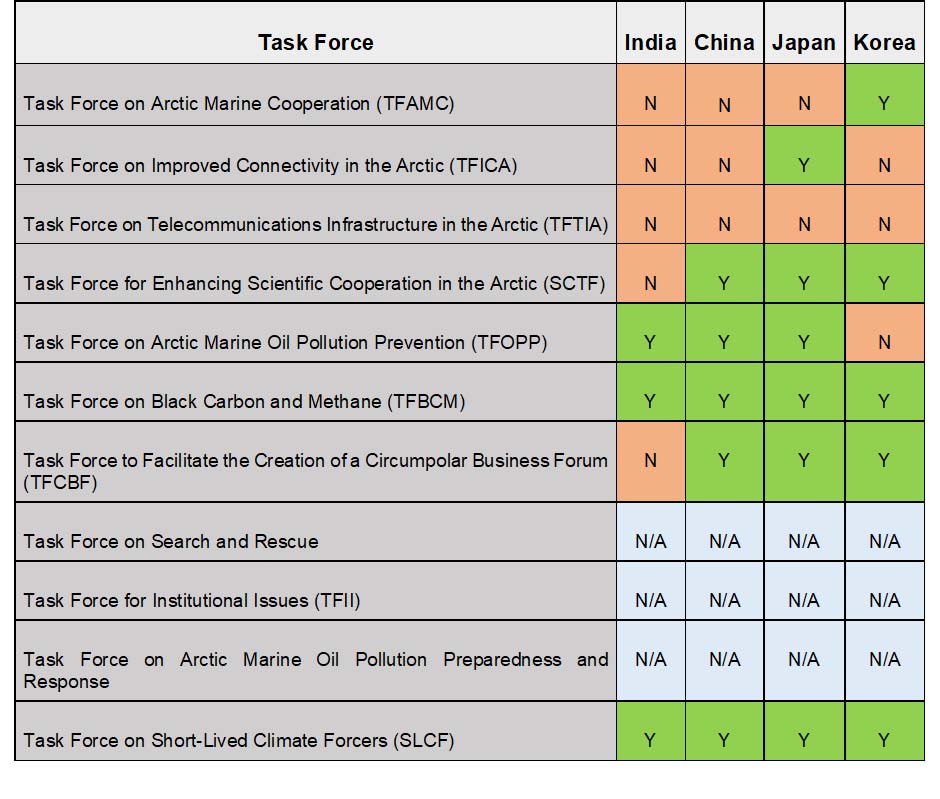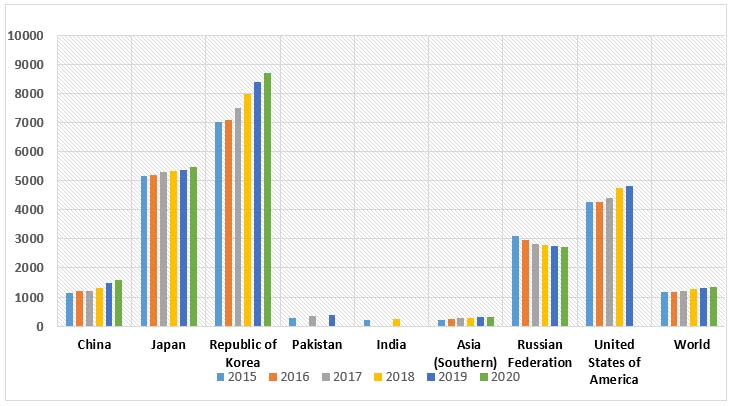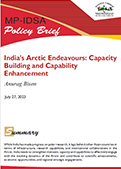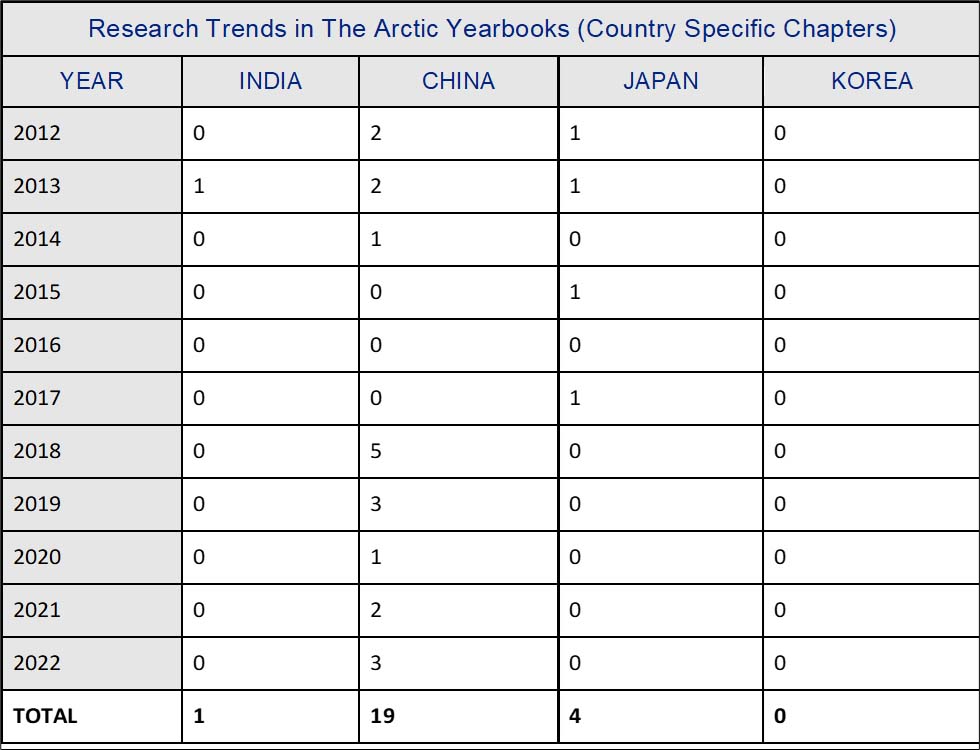You are here
India's Arctic Endeavours: Capacity Building and Capability Enhancement
Summary
While India has made progress on polar research, it lags behind other Asian countries in terms of infrastructure, research capabilities, and international collaborations in the Arctic. India needs to strengthen domestic capacity and capabilities to effectively engage with the evolving dynamics of the Arctic and contribute to scientific advancements, economic opportunities, and regional strategic engagements.
Introduction
Capacity building and capability enhancement remain central to India’s Arctic endeavours. While ‘capacity’ refers to material adequacy, ‘capability’ refers to the possession of domain-specific qualifications, expertise, and skills. While capacity can be built rapidly, capability is realised incrementally over a period of time through the intellectual and educational processes of training, learning, operational experience, and equipment exploitation. An important consideration as regards national capacity and capability is that in the former case, the timelines can be shortened through acquisition, such as by buying an ice-class research vessel off-the-shelf or by renting such a vessel. However, capability – particularly in critical and niche domains, is acquired by nations over time.
India’s Arctic Policy 2022
The relevance of the Arctic for India can be broadly explained under three categories: Scientific Research, Climate Change and Environment; Economic and Human Resources; and Geopolitical and Strategic reasons.1 Geopolitically, the Arctic is significant for India because it is an arena of strategic contestation for two of its most important strategic partners, the US and Russia and its principal adversary, China. The sheer range of the issues that impact the Arctic – from climate change, connectivity, resource development, and big power confrontation, have significance for the whole world, including India.
India’s Arctic Policy (hereinafter Policy), issued in 2022, is cognisant of our inadequacies in the Arctic and has, hence, rightfully designated National Capacity-Building as its sixth pillar. The other five pillars also include aspects related to capability enhancement and capacity building. The Policy aims to enhance India’s capacities in the Arctic through the development of a robust human, institutional, and financial base.2 This is sought to be achieved by strengthening the National Centre for Polar and Oceanographic Research (NCPOR) and other relevant academic and scientific institutions in the country, identifying nodal institutes, and promoting partnerships among institutions and agencies.
The policy also intends to promote research capacities in Indian universities in Arctic-related fields; broaden the pool of experts in Arctic-related sectors such as mineral, oil, and gas exploration, blue-bio economy, and tourism; strengthen training institutions for training seafarers in polar/ice navigation and develop region-specific hydrographic capacity and skills required to undertake Arctic transits; develop indigenous capacity for building ice-class ships; expand India's trained manpower in maritime sectors; and build broad institutional capacity for the study of Arctic-related maritime, legal, environmental, social, policy, and governance issues. India’s Arctic Policy also hopes to promote a larger pool of experts in the government as well as academia and also create capacities for research in the country on Arctic governance and geopolitics.3
Mapping India’s Current Arctic Engagements
India, China, Japan, South Korea, and Singapore are the five Asian countries who joined the Arctic Council as Observers in 2013. A comparative analysis of India, China, Japan, and South Korea's capacity building activities can help in understanding why capacity building is crucial.
|
Event |
India |
China |
Japan |
South Korea |
|
Svalbard Treaty |
19204 |
1925 |
1920 |
2012 |
|
1st Research station |
2008 |
20045 |
1991 |
2002 |
|
2nd Research Station |
- |
2018 |
- |
- |
|
International Arctic Science Committee |
2012 |
1996 |
1991 |
2002 |
|
1st Expedition to the Arctic |
2007 |
1999 |
1998 |
1999/2010 |
|
1st NSR Voyage |
- |
2012 |
20116 |
20137 |
|
1st Nordic Summit |
2018 |
- |
19978 |
20089 |
|
Arctic Policy |
2022 |
2018 |
201510 |
201311 |
|
Observer Status |
2013 |
2013 |
2013 |
2013 |
|
1st Polar Research Vessel |
|
1999 |
199812 |
200913 |
|
Svalbard Integrated Arctic Earth Observing System |
Associate Partner |
Formal Partner |
Formal Partner |
Formal Partner |
|
Central Arctic Ocean (CAO) fisheries agreement |
- |
2015 |
2015 |
2015 |
|
Uarctic (University of Arctic) Affiliations |
3 |
13 |
1 |
2 |

As can be seen from the above table, India has the leading rank only on two occasions. In 1920, India, as a dominion of the British, along with Japan, was one of the original 14 High Contracting Parties to sign the Svalbard Treaty. Thereafter, in 2013, we became Observers together with the other four Asian states.
To be sure, India has made tremendous strides in polar research, being one of two developing nations to have a research station in the Arctic. India has lagged behind the other three Asian Arctic Observer countries, however, as regards the first expedition to the Arctic or setting up of a research station or the release of an Arctic Policy.
Table 2 compares India’s participation in Arctic Council Task Forces with the other Asian Observer states, except Singapore. Japan figures in the highest at six, China and South Korea are at five each, while India has participated in three Task Forces.

Source: Author’s tabulations from The Arctic Council
Table 3 compares country-specific chapters in the Arctic Yearbook for a 10-year period from 2012. China tops the list with 19 mentions, Japan is placed second with four mentions, while India is placed third with one mention. This reflects the inadequacy of Arctic-related research, economic and political activity being undertaken in India and indicates the lack of capacity and capability on the Arctic in the country.
|
India |
China |
Japan |
South Korea |
|
-Norway
-Japan
-Canada |
- Trilateral Dialogues with Japan and Korea
|
-Arctic Challenge for Sustainability |
-Arctic Partnership Week
-Korea Arctic Research Consortium |
Source: Author’s Tabulation Based on Open Source Information.
Table 4 shows the key international Arctic-related collaborations and activities of India, Japan, China and South Korea. While India has a bilateral dialogue with Russia on the Arctic, the MoU with Polar Knowledge with Canada was signed in 2020. There are also engagements with institutions in Norway and Japan, albeit on a smaller scale. In comparison, however, international collaborations and Arctic-related activities of China, Japan and South Korea are far more developed. For instance, the three countries have a trilateral dialogue.
China also has bilateral dialogues on the Arctic with Russia, US, Norway, Denmark, UK, and France. Additionally, there is a China-Nordic Research Centre (CNARC) which is an international consortium initiated by the Polar Research Institute of China (PRIC) in collaboration with respective institutes in the Nordic countries to promote and facilitate China-Nordic cooperation for Arctic research.14 China has also established an Arctic Science Observatory in Iceland, a joint project by Chinese and Icelandic research institutions to further the scientific understanding on Arctic phenomena.15 China’s first overseas land satellite receiving station – China Remote Sensing Satellite North Polar Ground Station (CNPGS), has also been established in Sweden.16

Source: “Science, Technology and Innovation”, UNESCO Sustainable Development Goals.
Table 5 shows comparative data of researchers per million inhabitants (RPMI) of India with China, Japan and South Korea, as well as US and Russia. The RPMI is UN Sustainable Development Goals (SDG) Indicator 9.5.2 and is defined as the number of professionals engaged in the conception or creation of new knowledge (who conduct research and improve or develop concepts, theories, models, techniques instrumentation, software or operational methods) during a given year expressed as a proportion of a population of one million. In 2018, India had 252.7 RPMI, one fifth of the world average of 1265 RPMI. The corresponding figures for China, Russia, US, Japan and South Korea are 1307.1, 2784.3, 4748.8, 5331.1, and 7980.4 respectively.
India and Polar Research
Presently, India’s polar research for Antarctic, Arctic, Southern Ocean and Himalayas is budgeted under the umbrella of Polar Science and Cryosphere (PACER) programme of the Ministry of Earth Sciences (MoES).17 The total financial allocation (BE) under the PACER programme for 2018–19, 2019–20 and 2020–21 was Rs 365 crores.18 For 2022–23, the demand for grants under PACER is Rs 140 crores, while that for NCPOR is Rs 23.67 crores.19 This amounts to approximately US$ 17.5 million for the overall PACER programme and approximately US$ 3 million for the NCPOR for the year. Considering that India’s Antarctic Programme is about five times bigger20 than its Arctic programme, it is estimated that allocations for the Arctic are approximately Rs 10–15 crores per year or between US$ 1.5–2 million annually.
It is noteworthy that the entire MoES budgeted expenditure for FY 2022–23 is Rs 2,653.51 crores (~US$ 350 mn). This includes the budgets for the Ministry Headquarter in New Delhi; the two attached offices—the Centre for Marine Living Resources and Ecology (CMLRE) and the National Center for Seismology (NCS); two subordinate offices—the India Meteorological Department (IMD) and the National Centre for Medium Range Weather Forecasting (NCMRWF); and five autonomous institutions—National Institute of Ocean Technology (NIOT), National Centre for Polar and Ocean Research (NCPOR), Indian National Centre for Ocean Information Service (INCOIS), Indian Institute of Tropical Meteorology (IITM) and National Centre for Earth Science Studies (NCESS).
This meagre budget of approximately US$ 350 million caters for provision of national services for weather, climate, ocean and coastal state, hydrology, seismology, and natural hazards. It also caters for exploring and harnessing of marine living and non-living resources in a sustainable manner and to explore the three poles of the Earth (Arctic, Antarctic and Himalayas).
To contextualise the MoES’ Arctic budget, it is pertinent to highlight the South Korean example. The Korea Polar Research Institute (KOPRI) is the primary (government sponsored) research institute for the national polar programme in South Korea. KOPRI runs a research station in Svalbard and has a number of pan-Arctic observation sites. It is involved in around 20 Arctic (large and smaller) projects, sends around 200 expeditioners a year to the Arctic and has an investment of approximately US$ 13 million (in research grants). This is just one of the Korean institutions engaged in Arctic Research. The Korea Arctic Research Consortium is yet another new initiative (launched in 2015), with 30 partner institutions and a secretariat at KOPRI that aims to strengthen collaboration in Korean Arctic research and bring together science, industry and policy.21
A 2018 commentary in Nature claimed that China has earmarked US$ 3 billion for polar research over the next decade. China also raised its financial inputs in Antarctic research. From 2001 to 2016, China invested 310 million yuan (about US$ 45 million) in related projects, which is 18 times the total for the period 1985–2000.
In terms of research capacities, against a world average of 1.9 per cent of GDP on research, India’s expenditure at under 0.7 per cent is less than half. The corresponding figures for China, Japan and S Korea are 2.4 per cent, 3.2 per cent, and 4.8 per cent respectively. There are 13 Chinese institutions affiliated to the University of the Arctic (UArctic) against three from India, of which two became members recently (in May 2023).22
Polar studies also remain largely absent from schoolbooks for secondary and senior secondary levels. About 25 Institutes and Universities are currently involved in Arctic research in India and about a hundred peer-reviewed papers have been published on Arctic issues since 2007.23 India’s academic capacity needs to be substantially augmented at all levels, from primary and secondary education to higher education and post-doctoral studies, in order to compete with China, Japan, and South Korea.
On 28 June 2023, the Union Cabinet approved the introduction of the National Research Foundation (NRF) Bill 2023 in the Parliament that will seed, grow and promote Research and Development (R&D) and foster a culture of research and innovation throughout India’s universities, colleges, research institutions, and R&D laboratories. With an initial budget of Rs 50,000 crore over five years, the NRF aims to address the lack of funding for R&D in India.24 Modelled after the National Science Foundation (NSF) of the United States, the NRF will cover various fields, including natural sciences, engineering, social sciences, arts, and humanities, with a focus on finding solutions to societal challenges in India.
The establishment of the NRF is seen as a major milestone for science in India, aiming to improve research capabilities, promote a research culture, and link research to society and industry. The setting up of NRF will address a long-standing policy gap and if managed well, has the potential to address the inadequacies in India’s scientific research sector. The NRF will be administratively housed in the Department of Science and Technology (DST) and will be overseen by a governing board and executive council with funding for research projects shared between the DST and industry. It will foster collaboration between academia, government, and research institutions. It is hoped that India’s Arctic research efforts will also get a boost and new horizons for Artic research will be opened
Policy Recommendations
Whole-of-Nation Approach
India’s 2022 Arctic Policy was intended for a whole-of-government approach. It is crucial to adopt a whole-of-nation approach to build capacities and enhance capabilities, with active participation of industry, academia, and think tanks.
Interdisciplinary Research
It is essential to adopt an interdisciplinary research approach in order to understand not only the climate change-induced changes in the Arctic environment, but also the geo-strategic contestation that are underway, which have many scientific and policy implications. To conceptualise and conduct policy-relevant research on the Polar Regions, a multidisciplinary group of specialists need to collaborate closely within a single academic unit to develop viable research projects and academic programmes.
Domestic research capacities need to be promoted by expanding programmes in Arctic-related earth sciences and climate change in Indian universities. For this, Polar Research Chairs, faculty and facilities in select Indian universities would need to be established. Introduction of a Master of Science and PhD programmes in Polar Studies by institutions such as the NCPOR can further generate research capabilities.
In addition, expanded cooperation with the various Arctic science and research institutes and Indian institutes such as the Himalayan Science Council and IITs can enhance capabilities. Knowledge and expertise on Arctic maritime legal issues, for instance, can help us examine issues like the implication of opening of Northern Sea Route in the context of China’s Malacca Dilemma.
Expedite Acquisition of Polar Research Vessel
The lack of a dedicated Polar Research Vessel (PRV) is a serious impediment in the growth of India’s polar activities. On 29 October 2014, the Cabinet Committee on Economic Affairs had approved the acquisition of a PRV at a cost of Rs 1,051.13 crore within 34 months. The vessel, however, is yet to be acquired.
Enhance International Arctic Cooperation
China, Japan and South Korea undertake trilateral cooperation on Arctic. India could discuss Arctic bilaterally with Russia and Japan and thereafter have separate discussions on the Arctic with the Nordics, as part of the India-Nordic Summit, not just at the Track 1 level but at Track 1.5 and Track 2 levels as well. As India completes 10 years as AC Observer, like its counterparts, India should consider hosting AC events to increase its engagement with the Council members.
Rename MoES as Ministry of Ocean and Earth Sciences (MOES)
This can generate greater public consciousness of the oceans, especially to mitigate some effects of sea-blindness in the land-centric bureaucracy. Although it could be argued that Earth Sciences includes Ocean sciences, the word Earth is largely identified with land rather than oceans which cover 70 per cent of the earth’s surface. It may be recalled that the erstwhile NCAOR was renamed as NCPOR, to convey a wider geographical coverage. Three of MoES’ autonomous institutions have the word Ocean in their names and it is only right that the ministry also reflects the primacy of Oceans in the work that it undertakes. The NCPOR obviously needs to be suitably strengthened and fresh recruitment of scientists exclusively for Arctic research needs to be undertaken.
Establish a Think Tank for Earth Sciences, Oceanographic and Polar Affairs
The think tank, under the aegis of the MOES, could work on India-specific Arctic and Antarctic-related projects apart from the scientific field, polar and oceanographic affairs and earth sciences. Aspects related to geo-politics, governance, maritime law, connectivity, energy security and trade, among others can be given focussed attention.
Include members from the Academia, Think Tanks and Industry in the EAPG
The execution and implementation of India’s Arctic Policy is being undertaken through an inter-ministerial Empowered Arctic Policy Group (EAPG).25 The EAPG ought to include members of the academia, think tanks and the industry to broad base Arctic-related endeavours in India.
Conclusion
India's engagement in the Arctic requires significant efforts to build capacity and enhance capabilities. While India has made progress in polar research, it lags behind other Asian countries in terms of infrastructure, research capabilities, and international collaborations in the Arctic. Limited budgetary allocations for Arctic research and low expenditure on R &D indicate the need for increased investment and resources.
To address these gaps, India must prioritise the acquisition of necessary infrastructure, invest in R &D, and strengthen training institutions. This includes the acquisition of a dedicated PRV, promoting interdisciplinary research approaches, and expanding programmes in Arctic-related fields at Indian universities. Collaboration with Arctic science and research institutes, as well as international partnerships, should be fostered to enhance India's presence and contributions in the region.
Furthermore, India needs to adopt a whole-of-nation approach – involving industry, academia, and think tanks, to build a comprehensive institutional base on Arctic issues. By strengthening domestic capacity and capabilities, India can effectively engage with the evolving dynamics of the Arctic and contribute to scientific advancements, economic opportunities, and strategic engagements in the region.
Views expressed are of the author and do not necessarily reflect the views of the Manohar Parrikar IDSA or of the Government of India.
- 1. Anurag Bisen, “India’s Arctic Policy: Building a Partnership for Sustainable Development”, Issue Brief, Manohar Parrikar Institute for Defence Studies and Analyses (MP-IDSA), 17 March 2022.
- 2. “India’s Arctic Policy: Building a Partnership for Sustainable Development”, Ministry of Earth Sciences, Government of India, 2022, Article 7.
- 3. Ibid.
- 4. Dongmin Jin, Won-Sang Seo and Seokwoo Lee, “Arctic Policy of the Republic of Korea”, Ocean and Coastal Law Journal, Vol. 22, No. 1, Article 7, February 2017.
- 5. “China”, The Arctic Institute.1 August 2022.
- 6. Malte Humpert, “The Future of the Northern Sea Route - A ‘Golden Waterway’ or a Niche Trade Route”, The Arctic Institute, 15 September 2011.
- 7. Young Kil Park, “South Korea’s Interests in the Arctic”, Asia Policy, No. 18, July 2014, pp. 59–65.
- 8. “Japan-Nordic Summit Ends with Focus on Environment, Welfare”, The Japan Times, 27 June 1997.
- 9. Dongmin Jin, Won-Sang Seo and Seokwoo Lee, “Arctic Policy of the Republic of Korea”, no. 4.
- 10. “Japan’s Arctic Policy”, The Headquarters for Ocean Policy, 16 October 2015.
- 11. Melina Kourantidou, “Journey to S. Korea: A Tale of Arctic Marine Resources”, MERECONOMICS, 21 August 2018.
- 12. Yoshio Nagata, “Japan Joins Arctic Race with 1st Research Icebreaker for Region”, Nikkei ASIA, 18 December 2021.
- 13. “South Korea”, The Arctic Institute.
- 14. “China-Nordic Arctic Research Center”.
- 15. “China Iceland Arctic Research Observatory”.
- 16. “Kiruna North Polar Ground Station”, GlobalSecurity.org.
- 17. “PACER”, Ministry of Earth Sciences, Government of India.
- 18. “Demands for Grants (2021-2022) of the Ministry of Earth Sciences (Demand No. 23)”, Report No. 347, Rajya Sabha, Parliament of India, 8 March 2021.
- 19. “Detailed Demands for Grants of Ministry of Earth Sciences for 2022-23”, Government of India.
- 20. India has launched 43 expeditions to Antarctica.
- 21. Melina Kourantidou, “Journey to S. Korea: A Tale of Arctic Marine Resources”, MERECONOMICS, 21 August 2018.
- 22. “UArctic Assembly 2023 - Day 1: Key Decisions”, UArctic, 24 May 2023.
- 23. “Union Minister Dr. Jitendra Singh releases India’s Arctic Policy in New Delhi today”, Press Information Bureau, Ministry of Earth Sciences, Government of India, 17 March 2022.
- 24. “Cabinet approves Introduction of National Research Foundation Bill, 2023 in Parliament to strengthen research eco-system in the country”, Press Information Bureau, Ministry of Science and Technology, Government of India, 28 June 2023.
- 25. “India’s Arctic Policy: Building a Partnership for Sustainable Development”, no. 2, Article 8.0.3.




